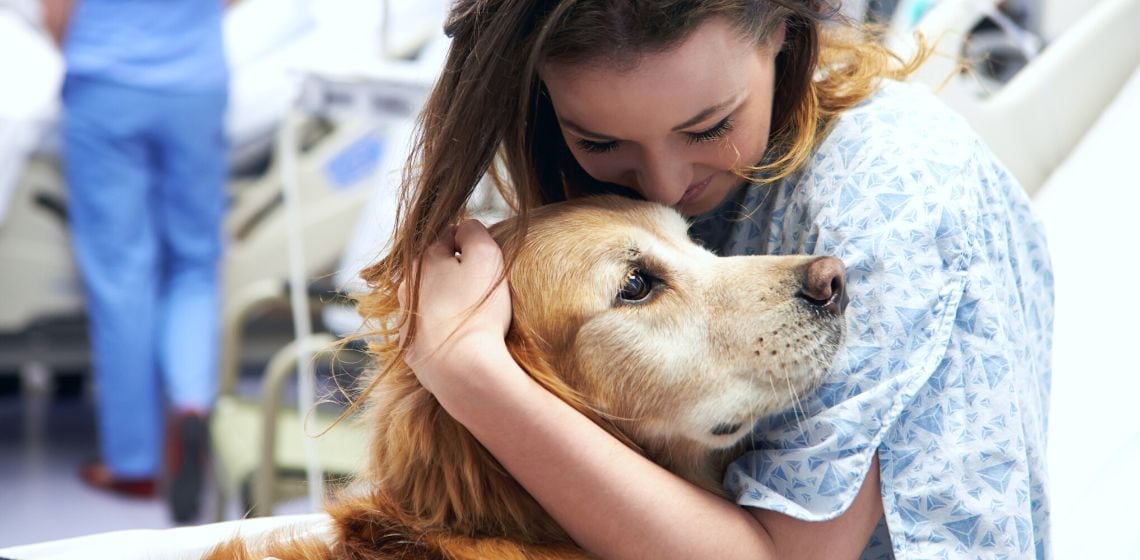Table of Contents
Therapy Pets Benefits:
Mental Health
Interacting with therapy pets can have a positive impact on mental health by reducing anxiety, depression, and loneliness while increasing feelings of happiness and comfort. Studies have shown that spending time with animals increases levels of oxytocin, a hormone that promotes feelings of trust, calmness, and joy.
Physical Health
Not only do therapy pets make people happy, but they also provide several physical health benefits as well. These animals can help lower blood pressure, decrease heart rate, and lower cortisol, a hormone associated with stress. People with motor skill impairments, such as patients recovering from a stroke, can also make great progress through a game of fetch with a therapy dog or even simply petting a therapy pet.
Social Skills
Therapy pets can help individuals with social anxiety, autism, or other conditions to feel more comfortable and confident in social situations. They also encourage communication and interaction with others.
Therapy Pets Versus Service Animals
The main difference between therapy pets and service animals is that service animals are trained to perform specific tasks for their handlers, such as guiding individuals with visual impairments or alerting individuals at risk for seizures. Meanwhile, therapy pets provide emotional support and companionship through animal-assisted activities that promote physical and mental well-being. While service animals have legal rights to access public places, therapy pets don’t. They’re invited into places such as hospitals and schools by staff and patients, and they must follow the rules and regulations of the facility they are visiting. Therapy pets are not protected by the Americans with Disabilities Act (ADA) and don’t have the same rights as service animals.
Types of Therapy Pets:
Dogs: Canine companions are the most popular species of therapy pets by a landslide. According to Pet Partners, the largest therapy pet organization, 94% of therapy animals are dogs. Golden Retrievers, Labradors, and Poodles are popular therapy dog breeds due to their gentle nature, intelligence, and trainability.
Cats: Cats can be a great option to provide emotional comfort and are particularly useful for individuals who may be allergic to or fearful of dogs.
Horses: Equine-assisted therapy is gaining popularity in treating an array of physical and mental health conditions, particularly through activities such as horseback riding and grooming.
Therapy animals can also include rabbits, guinea pigs, and birds.
How Does an Animal Become a Therapy Pet?
Not all well-mannered, friendly pets automatically qualify as therapy animals. First, the pet must go through temperament testing to ensure it remains calm and friendly around strangers, other animals, and in different environments. The animal needs to be comfortable being touched, petted, and hugged by people of different ages and backgrounds. Therapy pets need to be trained and evaluated by accredited organizations such as Therapy Dogs International, Pet Partners, or Alliance of Therapy Dogs. The training process can take several weeks or months, and the animal must pass a test of their skills and behavior before it can be certified as a therapy pet.
Becoming a Therapy Pet Owner
Becoming a therapy pet owner can be a rewarding experience that helps you give back to your community while spending time with your furry friend. However, it’s important to consider the costs, time commitment, and legal requirements before you decide to pursue this path. The first step is to research the specific type of therapy pet that aligns with your interests and lifestyle to ensure the best match for you and your animal. To become official, you enroll and receive certification from recognized organizations such as Pet Partners or the American Kennel Club to ensure the highest standards of training and handling.
Therapy pets make it their job to put a smile on everyone’s face. Whether they are providing companionship to a nursing home resident, supporting a child through their hospital stay, or aiding a patient after suffering a stroke, these special animals show us how truly lucky we are to have these furry friends in our lives.

Emily is a veterinary technician with over 6 years of experience in the field. She knew since she was a child that she was meant to work with animals. She started her career working in veterinary ophthalmology and has since worked her way to general practice. Emily now works as a surgical technician working in the operating room. When not at work, Emily spends her time with her husband and her small zoo of 3 dogs, 4 cats, 5 ducks, and 5 chickens.








